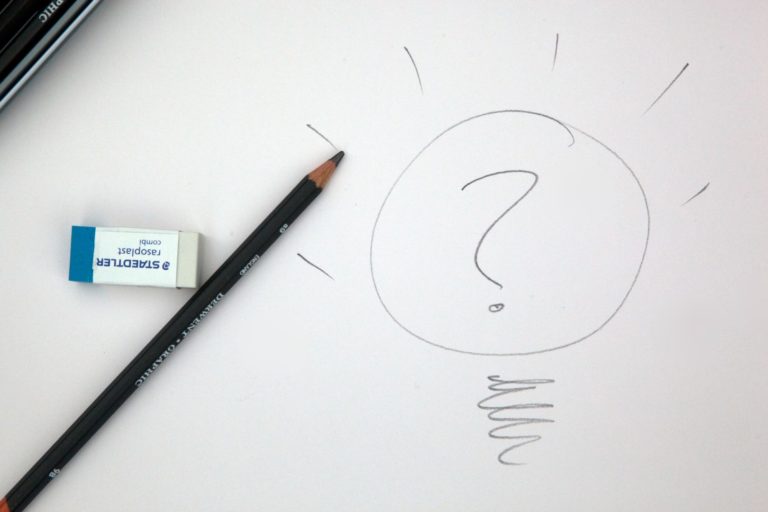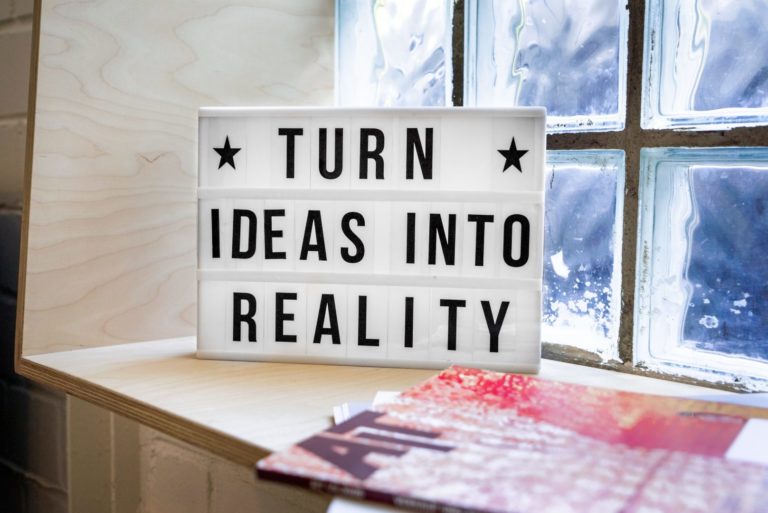This, in turn, will help make sure your developer gives you more concepts that you like and will work. Here at the Peterman Firm when a client wants branding to be a true focus, we don’t just use product developers. We bring in our branding experts to give your product the best chance of success possible. Branding is always important to us and the clients we work on.
Risk Averse
When you start with an idea, the potential is low and the risk is high. This means investors and buyers are highly unlikely to put money toward your idea in any way. Most business are risk averse. Two factors contributing to their level of aversity are typically how old and established the business is or how many people or companies own it.
BLANK
Ian Peterman, CEO Tweet
That’s why inventors, entrepreneurs, and small business are usually the ones innovating. Larger businesses survive and grow by making safe calculated risks that create slow steady growth. Smaller entities and individuals are usually more willing to invest or be involved in high risk projects.

However, that usually means they don’t have the cash needed to make this ideal for you, the person with the idea. You as the person, or small business, with the idea have a lot more to gain, and quite possibly less to lose, by developing it.
Ideas Don't Sell

We live in a highly connected world with billions of people. Ideas are so cheap that the phrase “a dime a dozen” doesn’t even apply anymore. I can get ideas and input from complete strangers quickly and cheaply. Your idea may have value to someone somewhere, but it will take a lot of time and effort to find the right person.
I’ve seen inventors sit on their ideas for over a decade looking for someone interested. For reference, a patent is only good for 20 years. That means the idea value drops as time goes on, if you aren’t working on it.
As an idea is developed, it’s value will follow the curve above. People like to talk about the “potential” of an idea. Yes, some ideas have better potential than others. However, even a “high” potential idea means nothing if no one does anything with it. It’s still just an idea. Value comes from moving the idea from idea to business.
Basically, when an idea first comes out, the sky’s the limit, but no one has proven anything. This means there is a high chance of failure. Businesses don’t want to buy into that. When you begin investing money into developing that idea into a product, however, the tables start to turn.
Chance of Investment
BLANK
Ian Peterman, CEO Tweet
The chance of investment increases as value builds. Your investment into the idea creates this build in value. If the idea is proven, it becomes more valuable and more likely to gain investment or potential buyers.

That point where it goes from an idea to a proven idea is where risk and value cross and is your ideal starting point for investment or sale. Here is where the idea is designed, developed, and ready for production. The product and idea will be more valuable if the idea is protected with patents and other legal documents. That is where you want to sell.
The Sell Point

The sell point is also usually the point where investors would be most interested, though some more risk friendly investors will start before then. This is just the beginning though. The ideal point of sale or investment is somewhere between that point, and it being a full-scale business. You will get the least amount of money at this point, but it is also where the real costs just start to add up.
BLANK
Ian Peterman, CEO Tweet
Because of where this point is, no inventory, marketing, or tooling are purchased, and a team isn’t hired. Those are things an established company would already have, and therefore this is where they start looking at buying. You can patent something that doesn’t work. So, when you get to this point, you have what’s called “real IP”. Having a patent and proof of concept is gold.
You will see products at this point in development start showing up on Kickstarter as well. They show you a beautiful prototype, their designs and sketches, and a nice marketing video. However, they need the larger investment for tooling and the first order of manufacturing in quantity to make pricing work.
Idea to Business
Really this is the story of idea to business. Once you start crossing over into the business side of things, people are more interested in buying or investing. Not everyone sells just before becoming a “real” business, but there are many inventors that do this.
They prove it works, patent it, get it as ready as they can, and then find a buyer. It’s much easier to find a buyer when you have something in hand that works. Think about the show Shark Tank. No one goes on there with just an idea and gets an investment. They have to have something real already.
Make your product go from idea to business and you’ll find where value and risk cross. You’ll know because people will start being interested. It’s different for every product where exactly it is and you might even have an idea that someone things is so amazing they offer to buy it as soon as they hear it. Either way, just make your idea real, and along that path you’ll find the right buyer or investor.
Final Thoughts
BLANK
Ian Peterman, CEO Tweet

In my experience of watching inventors pitch their idea, the very beginning is the hardest, and it gets easier and easier as you move forward with investing your own money. By taking away the heavy risk at the beginning, you create a much more attractive product for any company buying your product or investing large amounts.
I’ve seen many patents expire because they were looking for funding based just on the idea. Because they did this, instead of moving the ideal along, they ended up with no product, no business, and no profit. They never moved it out of the super high risk zone and into something that investors and buyers would be willing to go for.
Make sure you are willing to invest enough into the product to maximize your selling potential. Partnering with a good developer can bring resources to the table to help you with this and every other stage of the process.
Your Next Steps
Related Conscious Design BLOG Posts
What’s a Feasibility Study?
A feasibility study is a very important step in making sure a product will be successful. I break down what they are and why they matter.
What it Takes to Develop a Smart Product
As the Internet of Things has grown over the years, smart products have become a pretty hot item. Many people have product ideas for turning a “dumb” product into a “smart” one. It’s great, I love that we are improving our tools and gadgets in so many new and interesting ways. Technology is something that amazes me, and will probably continue to do so for the rest of my life. For a lot of people, it might seem like a fairly simple task to just add some electronics to a product and make it smart. You should understand what you or your business will need to developing such a product. You might have gotten an idea about what it really takes in our post a couple weeks ago Time, Budgets, & Luxury, but I’d like to dive more into exactly what it takes to create a smart product. There is a lot of time and effort that is beyond what low-tech products need to become a reality. For us, “smart” is anything that contains electronics that can connect to other electronics, so wi-fi, Bluetooth, NFC, USB, etc, usually there are sensors or other input points that collect data to be shared with other devices. Putting a motor into a mower doesn’t make it “smart”. Putting a computer on board with internet access, connected to an app would make it “smart”. A “smart” product doesn’t always have to touch the internet either, there are many closed circuit smart devices. IOT (internet of things) products MUST touch the internet however. In no particular order, here is a breakdown of everything that goes into developing a “smart” product. This will give you an idea of what you can expect if you choose to dive into this process. Disciplines required Most “dumb” products can get away with just an Industrial Designer or Mechanical Engineer. Both work, but you can read more about the differences in our post3 Things You Should Know About Designers & Engineers. No electronics means no coders, no electrical engineers, and many others. If you are working with basic electronics, such as motors, switches, etc, you can sometimes avoid getting an electronics person involved. BLANK Ian Peterman, CEO Tweet There are many mechanical side people who can make that happen. Now, if we’re creating a “smart” product, we will need these: App Design & Development Electronics Design Electrical Manufacturing Web Design & Development There are possibly a few others depending on how big you go, such as database development, but these areas would cover most of the work needed to get the project done. Time It can easily double the amount of time to design and develop a new product by adding in electronics that would make a product “smart”. Does this mean it would take longer on a calendar? Not necessarily. When we can, we prefer to do side-by-side development of the mechanical and electrical. This ensures both sides work together and keeps the timeline shorter. The collaboration between mechanical and electrical can really build some synergy with the project. The result is that issues can be caught earlier, avoiding them from popping up super late in the process where it’s harder and more expensive to fix. Cost BLANK Ian Peterman, CEO Tweet Double the time, at least double the cost. Electronics are usually more expensive to prototype. The benefit is the manufacturing on the back end makes super components, even fully custom ones. These products also sell for a higher premium than their “dumb” counter parts. Planning Working on more complex projects such as this involves a lot more planning and project management. Here at the Peterman Design Firm, that is one of our core competencies. You need to make sure the firm you work with has experienced Project Managers on its team. They also need to be able to handle the load required to bring such a product to life. BLANK Ian Peterman, CEO Tweet Network We’ve talked about how important your network is in our last post Building Your Network for Success. This is a place where it really matters as you need so many resources to get the project completed. If you are working with some of the very large and expensive firms out there, they probably have such a large in-house team they can handle most things, but you pay for it. Medium sized firms often still have the network and don’t do everything in-house. Small ones and freelancers don’t always have the network you need and are often still building them. The caveat of course is if they have been in business for 20 plus years, they probably have a good network. Feasibility Study BLANK Ian Peterman, CEO Tweet I put this here just because people like to skim, and this is a key part. Feasibility studies should never be skipped with products in this category. A feasibility study is very important to do at the beginning of your project. The firm you choose to use should be able to offer this service by itself. Don’t commit to full development until you know it can be done. A complete feasibility study from the Peterman Design Firm will give you cost expectations for the entire project, time frame, potential issues, project duration estimation and breakdown, and some market information on competitors. If you’d like to learn more about feasibility studies, check out our post What’s a Feasibility Study? When you have a great idea for a “smart” product, it’s at least worth getting a consultation on the idea. If your budget can handle it, a feasibility study would be valuable. Then if it looks good, invest the money. The great thing with “smart” products is that they are in high demand. Plus we seem to be on an exponential growth with them. For now, it’s a trend I feel will stay with us for a while, if not permanently. Your Next Steps Developing Smart Products What does it take to develop a smart product?
5 Tips for Market Research & Analysis
Wondering about Market Research & Analysis? This will give you a few tips on what it is and how to start your own research.


